A small distance, but a great feat: Foshay Learning Center sends more students to USC than any other high school

Foshay Learning Center (Glenn Koenig / Los Angeles Times)
Lilly Diaz was in second grade when she first stepped onto the campus of USC for a Halloween carnival organized by undergraduates. By the time she returned to the campus as a freshman this fall, she found nothing especially scary about it.
By then, the campus felt like a second home — for her and 29 other graduates of Foshay Learning Center who have enrolled as first-time students at the selective university.
“I feel like I belong,” Diaz said this week after a morning of classes and just before her trombone practice with the marching band.
Foshay, located in a hardscrabble neighborhood less than a mile west of the university campus, sent more students to USC this fall than any other public or private high school.
We are connecting with the surrounding community and building a pipeline to USC for students.
— Timothy Brunold, dean of admissions at USC
The accomplishment is major and no flash in the pan. It’s the product of a collaboration between the school and the university that has lasted more than 25 years.
“That’s one of the great stories of USC,” said Timothy Brunold, dean of admissions. “We are connecting with the surrounding community and building a pipeline to USC for students, especially those who are the first in their family to attend college.”
Diaz, 18, fits that description. Her parents emigrated from El Salvador. Her father, who works as a valet, finished high school in his native country; her mother, a custodian and stock clerk, left elementary school early to help out at home.
Both parents wanted more for their daughter. They were thrilled when Diaz’s fifth-grade teacher encouraged the quiet, studious girl to apply for a spot in USC’s Neighborhood Academic Initiative, a seven-year, college-aimed enrichment program.
Foshay, which runs from kindergarten through 12th grade, is a perfect fit: Students in the program get to progress from year to year without ever changing schools.
Diaz early on switched elementary schools three times as her single mother moved around for work. But after she started at Foshay in sixth grade, she stayed put — even when her mother moved to Virginia with Diaz’s three younger siblings. Everyone agreed that Diaz needed to stick with the program, so she moved in with her father, who lives near Foshay and USC.
At stake was a superlative high school education and a free ride — worth about $70,000 a year — if Diaz made it into USC.
“We understood that her mom had to leave, but we were always here,” Foshay Assistant Principal Yolanda McCoy said.
About 115 sixth-graders — three classrooms — enter the program annually at Foshay. By high school, that group usually is whittled down, through attrition or competition, to about 70.
Students in the program must maintain at least a C average, and families must commit to extra academics and enrichment during and beyond school hours. Monday through Friday, from 8 a.m. to 10 a.m., high school classes take place at USC.
“The experience of being on campus Monday through Friday is critical to the success of the program,” said Michael Laska, a math teacher who has been at Foshay for 28 years.
Diaz quickly took to it.
“It was exciting just to be in a college classroom and you’re only 11 or 12 years old,” she said. “I didn’t feel anxiety or nervousness because I was surrounded with students of my background. I got to be with my friends.”
Summer school is mandatory, as is Saturday school 20 weeks a year. Students take tough courses such as calculus. Parents must attend workshops on topics including planning for college and communicating with teachers.
Even students who leave the program are expected to graduate, and many go to other top universities. In Diaz’s class, 56 made it all the way through. The rules required all of them to apply to USC. Diaz was one of 21 who got in, and 19 of them enrolled. (The two others chose Harvard and Wesleyan.) Eleven others who came out of the program at Foshay transferred into USC this year after completing one or two years elsewhere.
A driving principle of the program is that USC will not lower its standards. Instead, the college commits to helping the Foshay students raise themselves up. Foshay became USC’s top feeder campus even as the university reported that it had admitted only 17% of applicants, its most selective enrollment. Among the 3,068 freshman, 610 students had perfect grade point averages and the average unweighted GPA was 3.75.
See the most-read stories in Local News this hour »
At the same time, 13% are first-generation college students. Foshay is crucial to the school’s diversity. Overall, USC’s freshman class is 41% white, 20% Asian, 14% international, 13% Latino, 6% multiethnic and 5% black.
Foshay, by contrast, is 80% Latino and otherwise mostly black. About 93% of its students are from low-income families.
USC has always had a complex relationship with its surrounding neighborhoods — sometimes shining like a beacon, at other times seeming more like an island or a fortress attempting to wall itself in. USC security roams just far enough into the higher-crime environs to offer a buffer of protection to the campus and the adjacent streets where many students live.
But the college has made a real commitment to Foshay and other nearby schools. At Foshay, the help goes beyond the program. All the school’s students benefit from guest teachers, after-school tutoring and elementary-school reading buddies.
Foshay also does not leave all the heavy lifting to USC. The school has four themed academies and a faculty that is known for remaining in place for decades. Its robotics teams have won prestigious competitions. Its jazz band, in which Diaz performed, raised funds to travel to Paris.
This month brought a reminder of Foshay’s challenging environment. Foshay graduate Carlos Segovia-Lopez, 19, was shot and killed while sitting in his car blocks from the school. He’d completed the USC program and then decided to join the Marines. Foshay counselor Michael Hooks recalled his desire to help the homeless.
USC has recently expanded its initiative to several schools in East Los Angeles. The budget, funded by USC and donors, is $1.6 million but will need to grow to match the increasing ambitions.
“This program changes the question from ‘Am I going to college? Can I go to college?’ to ‘Which college am I going to go to?’” said Kim Thomas-Barrios, executive director of USC Educational Partnerships. “They have this wonderful problem.”
Twitter: @howardblume
To read the article in Spanish, click here
ALSO
L.A. Unified has almost 700 unresolved complaints about broken air conditioning
A groundbreaking homeless shelter for college students in Santa Monica hits a snag
With a new e-sports arena, UC Irvine aims to become a mecca for gamers
More to Read
Start your day right
Sign up for Essential California for news, features and recommendations from the L.A. Times and beyond in your inbox six days a week.
You may occasionally receive promotional content from the Los Angeles Times.







